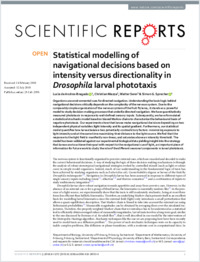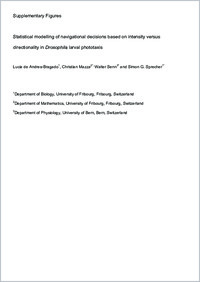Statistical modelling of navigational decisions based on intensity versus directionality in Drosophila larval phototaxis
- Andres-Bragado, Lucia de Department of Biology, University of Fribourg, Fribourg, Switzerland
- Mazza, Christian Department of Mathematics, University of Fribourg, Switzerland
- Senn, Walter Department of Physiology, University of Bern, Bern, Switzerland
- Sprecher, Simon G. Department of Biology, University of Fribourg, Fribourg, Switzerland
-
26.07.2018
Published in:
- Scientific Reports. - 2018, vol. 8, no. 1, p. 11272
English
Organisms use environmental cues for directed navigation. Understanding the basic logic behind navigational decisions critically depends on the complexity of the nervous system. Due to the comparably simple organization of the nervous system of the fruit fly larva, it stands as a powerful model to study decision-making processes that underlie directed navigation. We have quantitatively measured phototaxis in response to well-defined sensory inputs. Subsequently, we have formulated a statistical stochastic model based on biased Markov chains to characterize the behavioural basis of negative phototaxis. Our experiments show that larvae make navigational decisions depending on two independent physical variables: light intensity and its spatial gradient. Furthermore, our statistical model quantifies how larvae balance two potentially-contradictory factors: minimizing exposure to light intensity and at the same time maximizing their distance to the light source. We find that the response to the light field is manifestly non-linear, and saturates above an intensity threshold. The model has been validated against our experimental biological data yielding insight into the strategy that larvae use to achieve their goal with respect to the navigational cue of light, an important piece of information for future work to study the role of the different neuronal components in larval phototaxis.
- Faculty
- Faculté des sciences et de médecine
- Department
- Département de Biologie, Département de Mathématiques
- Language
-
- English
- Classification
- Biological sciences
- License
-
License undefined
- Identifiers
-
- RERO DOC 322817
- DOI 10.1038/s41598-018-29533-0
- Persistent URL
- https://folia.unifr.ch/unifr/documents/307040
Other files
Statistics
Document views: 142
File downloads:
- pdf: 166
- Supplementary material: 132

